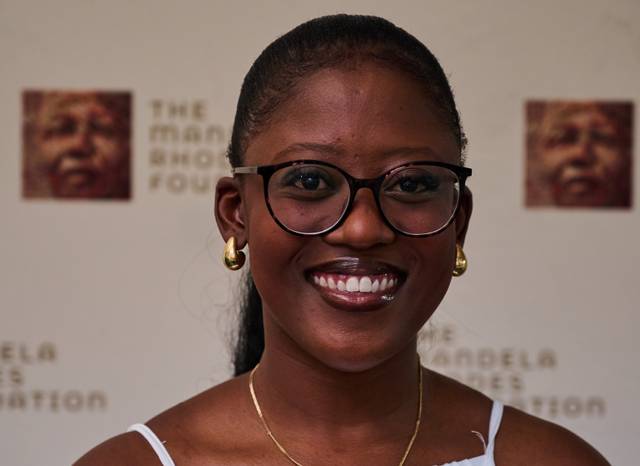
Alumni on the Move
UPDATE: Where are the 2024 Äänit Prize winners now?
Chido Dzinotyiwei (Zimbabwe & University of Cape Town, 2018) gives us an update on where things are since winning the 2024 Äänit Prize.
Chido’s venture, Vambo AI is a cutting-edge platform seeking to bridge language barriers in Africa by offering multilingual AI solutions (including translation, transcription and content generation) for better communication to empower education, business and governments. Headed up by, Vambo AI falls under the technology and data impact area.
What inspired you to enter the Äänit prize competition?
I was drawn to the Äänit Prize because of its focus on African-led solutions creating real impact for Africa. As a founder building language technology for African languages, I saw the Prize as an opportunity to gain recognition, support, and community for a mission that deeply matters - making technology more accessible across linguistic and cultural lines.
Why do you think Africa will benefit from your venture?
Africa is home to over 2,000 languages, yet most of these are underrepresented in digital systems. Vambo AI seeks to bridge that gap using generative AI to build tools that enable translation, transcription and content creation in African languages.
We are building solutions for inclusion, education, and access in a continent that is rapidly digitising, but risks leaving behind those who don’t speak dominant languages. This is also extremely important work as it preserves the essence of the African identity, which is captured in language and culture.
Which SDG does your venture align with and what major challenges does this industry face?
Vambo AI aligns primarily with SDG 4 (Quality Education) and SDG 10 (Reduced Inequalities). A major challenge is access to quality datasets and computing resources for low-resource languages. We also face the broader issue of limited funding for AI infrastructure, when rooted in African contexts.
What changes has your innovation brought to the continent?
We’ve increased awareness of the importance of language inclusion in tech and improved AI literacy through our workshops, YouTube channel, podcast, and collaborations with other organisations. Through Vambo AI, learners and businesses in South Africa and beyond can now access multilingual AI tools. We serve users and companies looking to localise their products and improve inclusion, enabling better reach and relevance.
We’ve worked with clients across several African countries - including South Africa, Zimbabwe, Kenya, Uganda, Rwanda, Nigeria, and Senegal - to support language and cultural preservation through technology.
What have you implemented since winning the prize?
Since winning the prize, we’ve added speech capabilities for five more African languages, conducted data collection initiatives to improve our models, and secured new strategic partnerships. We’ve also accelerated platform development and user outreach. Most excitingly, we’re on our way to open-sourcing some of our language AI resources to empower broader communities and drive further innovation across the continent.
What lessons have you learned about managing capital since winning the Äänit Prize?
We’ve learned the importance of having a clear strategy and work plan to enables our team to build assets and intellectual property with long-term commercial value. Every dollar needs to be intentional - whether it’s generating revenue directly or putting systems in place to strengthen the company’s longer term sustainabilty. Our approach now ensures that every investment made must either generate more revenue or enhance scalability and financial resilience..
In which area of your venture did the Äänit prize money make the most difference?
The Äänit Prize funding made the most difference in accelerating our technical development and data efforts. It allowed us to expand language coverage, enhance our speech capabilities, and improve the quality of our multilingual AI models. It also gave us the flexibility to invest in tools and partnerships that strengthened our product and positioned us for greater community impact and commercial readiness.
What did you learn through the application process that can be shared with this year’s applicants?
Be clear, concise, and authentic. The application process is a chance to reflect deeply on your impact and vision. So take the time to articulate not just what you do, but why it matters. Share tangible evidence of progress, and don’t be afraid to tell your story in a way that connects emotionally and practically. Most importantly, remember that you are the only one who truly understands your business, your plans, and your potential - so make sure you express that clearly and confidently.
How did you find the Äänit Prize pitching process?
The pitching process was challenging but incredibly rewarding. It required refining our message to clearly communicate both our social impact and our business potential in a short amount of time. One of the parts I enjoyed most was the detailed Q&A session that followed the pitch. It showed genuine interest from the panel and gave space for deeper conversation. That said, it also required thorough preparation to answer confidently and effectively across different aspects of our venture. Overall, it was a powerful learning experience in clarity, storytelling, and strategic thinking.
What innovation inspires you?
Smarter generative AI continues to inspire me — particularly innovations like coding assistants and co-pilots that help teams work more productively. These tools are transforming how we build, test, and ship ideas faster.
I'm also excited by tools like Opus Clip that use AI to repurpose long-form content into short, engaging clips — making content creation more accessible and scalable for small teams. It’s powerful to see how GenAI is evolving to solve real-world problems with speed, creativity, and context.
What do you think makes a profitable social impact venture?
A profitable social impact venture sits at the intersection of solving a real problem, creating measurable value, and building a model that can scale sustainably. It’s about designing with both purpose and pragmatism — ensuring your solution is not only mission-driven but also market-relevant. Business models that work well in this space include:
- Freemium or tiered-access models, where basic access is free to drive reach, while advanced features or enterprise solutions generate revenue.
- Partnership-driven models, where the venture leverages subject matter experts and strategic collaborators to reduce input costs while enhancing quality and credibility. This approach is especially powerful in resource-constrained environments, allowing for high-impact delivery with lean operations.
The most successful ventures deeply understand their users, build products people are willing to pay for (or support), and continuously align their operations with both impact and income generation.
What’s next for you?
We’re continuing to focus on scaling our impact across the continent. We're in the process of releasing open-source African language AI models to support broader innovation and community-led development. At the same time, we’re investing in better capacitating our team and infrastructure to expand into new regions of Africa. This includes refining our product, deepening partnerships, and continuing to advocate for inclusive AI that reflects and serves the diverse realities of our continent.







